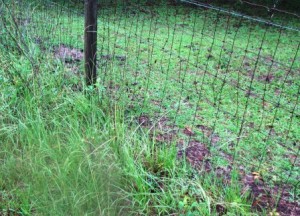 Jed Dillard
Jed Dillard
Jefferson County Extension
The short answers are “Because of your pasture management” and “Change your pasture management.” Here’s the slightly longer version.
After Jefferson County native Ed Finlayson discovered Pensacola Bahia it became widely used in the Deep South because of its low maintenance requirements. However, there are limits to how much abuse Bahia grass will take. Centipede’s emergence in the pasture is an indicator these limits have been surpassed.
Bahia grass plants store energy reserves in the roots and rhizomes. This energy is produced in the leaves, so overgrazed plants lose their capacity to persist or recover. Centipede plants respond similarly, but the plant is lower growing and more resistant to defoliation. (See photo)
What are other differences between Bahia and centipede and how can we use those differences to favor Bahia?
• Centipede will persist at a lower pH (As low as 4.5) than Bahia. If the pH is raised to at least 5.5, Bahia will be favored.
• Bahia grass is also more responsive to nitrogen fertilization than centipede. In fact, nitrogen rates of over fifty pounds per acre decrease centipede’s winter hardiness. Fifty pounds of nitrogen per acre is the IFAS Extension recommended rate for low intensity grazing of Bahia pastures. Additional nitrogen can provide additional grazing, but be sure to provide sufficient phosphorous and potassium as determined by a soil test. High fertilizer prices in the last few years have resulted in reduced amounts of lime and fertilizer being applied to many pastures. Consequently, centipede has benefited and your livestock has suffered.
Here are five steps to fight centipede encroachment in Bahia pastures.
1. Apply lime according to soil test requirements. Target pH for Bahia is at least 5.5. Lime takes a while to affect pH, so do this NOW.
2. If Bahia is still the primary grass in your pasture, apply fertilizer according to soil test recommendations. If centipede has taken over, you may want to skip to the next step.
3. If you have large patches of centipede, kill centipede patches with glyphosate herbicide.
4. Reseed any treated areas. If centipede encroachment has been a problem for more than a year, there may not be enough viable Bahia seed in the ground. Take advantage of the moisture from recent tropical storm Debby before it gets away.
5. Implement better grazing practices and maintain sufficient fertility. Rotational grazing will allow grass plants recovery time and can increase total forage yield. Dividing pastures with a single strand of temporary electric fence is one of the most cost effective improvements you can make to your grazing management.
Centipede didn’t take over your pasture in six weeks, so don’t expect reclamation to be instantaneous. Contact your local Extension agent for site specific assistance.
